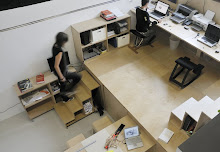
SAUNA FINLANDESA
Un proyecto de Iñaki Larrimbe
Inauguración. viernes 27 de junio 2008
a partir de las 21.30
pintorería 92 bajo. 01001 vitoria-gasteiz
El hecho que la cultura y el arte se consideren hoy, en la gestoría cultural, como recursos económicos como otros cualesquiera, ha impulsado que gran parte de los artistas jóvenes y menos jóvenes orienten algunas de sus prácticas y reflexiones en el ámbito económico de su propia práctica y el carácter político del hecho económico objeto de reflexión. El nuevo proyecto creativo que aborda Iñaki Larrimbe se suma a este lugar de reflexión y práctica, dando continuidad a un trabajo anterior realizado en el Hotel Álamo de Vitoria-Gasteiz durante la Semana Santa de 2007, donde el autor se propuso como turista en su propia ciudad realizando en ese tiempo un libro de viajes que daba cuenta de sus impresiones. Como en aquél, éste pone sobre la mesa el "turismo cultural" como banalización, si no perversión, del equipaje argumental de las políticas públicas sobre arte y cultura que han situado la problemática del arte y la sociedad en la agenda de los departamentos de promoción económica y planificación estratégica de los gobiernos actuales. Algunos artistas contemporános jóvenes han asumido en sus prácticas el "quintacolumnismo" como estrategia de tintes dadá inspirados en el alien u otras metáforas asignadas al virus, haciendo caso omiso a Nietzsche y a Severino que ya señalaron que el material del martillo con el que se intenta derribar el muro está hecho con el mismo material del muro a abatir. Esto plantea que al menos en el ámbito de la nueva economía capitalista el sabotaje más que improbable es imposible. Iñaki Larrimbe sospecha de este estado de cosas y quizá por eso decide poner interrogantes en el título del proyecto: Sauna finlandesa, o ¿descenso de barrancos? . Un principio de indecibilidad que anula tanto el sí como el no y abre a lo posible una pluralidad tan abiertamente sospechosa de la inoperancia o el sin sentido de la política. Una caravana alojada en el estudio del autor (una lonja en alquiler) se ofrece no tanto como forma de habitar barata sino como un modo de alojamiento temporal (fin de semana) para consumidores culturales. El proyecto de esta manera se aloja en un ámbito de reflexión crítica de la industria cultural no situándose frente a la industria y sus consecuencias que avalaría una disposición típicamente moderna, sino como participante nihilista del proceso. Como ya recordó Nietsche, no se puede ser nihilista del todo, pensamiento angular sobre el que se fraguó todo el arte desde los años 80 hasta ahora donde el pragmatismo es el medioambiente en el que se desarrollan las prácticas que habían pertenecido a la sociedad civil. Desaparecida ésta, claro está.
MAS EN: www.kreared.com/eu/multimedia/descargar/152


















